Cookbook #214: Making Your Own Baby Food, Mary Turner and James Turner, Bantam Books, NY, 1978.

I bought Making Your Own Baby Food when I was preparing to feed my first child his first solid foods. I think I probably bought this little paperback in a used book store.
I invite you to read my post Feed Me I’m Yours for more of my thoughts on the topic of homemade baby foods – I use my grandchildren as my test subjects!
In both books, the advantages of and recommendations for homemade baby foods pretty much agree with current advice given to new moms, except for the “no honey until a year old” rule. Also, some milk products and some foods known to be potential allergens are introduced more carefully these days (peanuts, for instance). Making Your Own Baby Food is a lot more serious than Feed Me I’m Yours, a book I described as “friendly and helpful”.
The introduction of Making Your Own Baby Food begins with the authors (a couple) relating how they began to study the nutritive value of foods when Mary Turner (the wife) was two months pregnant. They quickly changed their own diets, taking out the multiple daily sugary drinks. And then they delved a lot more into the subject of the foods we are offered by the food industries. They express their strong belief that the food industry does not necessarily produce food of good nutritional quality for its consumers, and more importantly, for baby foods. They back up their statements with bibliographic references. The print is small. Hence I call it a “serious” book. And I have to get out strong glasses to read it.
Part I is “Getting in Gear”. This section discusses how to start changing your diet for the better and how to prepare to nourish your unborn and then newborn child. Part II is “What You Should Kuow [sic] About the Baby Food Industry”. Here is a quote from this section:
“Foods that are specifically prepared for babies require separate consideration from all other foods as regards the use of food additives and toxicological risks. The reason for this is that the detoxicating mechanisms that are effective in the more mature individual may be ineffective in the baby. The Committee [WHO Committee] strongly urges that baby foods should be prepared without food additives, if possible. If the use of a food additive is necessary in a baby food, great caution should be exercised both in the choice of additive and in the level of use.” (excerpt from a 1962 World Health Organization publication)
Parts I and II are fully half of the book: this is not simply a recipe book.
Part III is “The Alternatives”. This section first discusses how to put in action a good nutrition plan for mom and baby, including breastfeeding. Breastfeeding is now quite common in the US (2017). But when I had my son in 1980, breastfeeding was only coming back as an upward trend, after a hiatus in the 1950s and 60s. For instance, my own mother was encouraged to use formula. Today breastfeeding in our area of America is encouraged – and they have human-milk banks for moms who are unable to breastfeed.
The discussion of how to transition from milk to solids begins: “Going from a diet made up entirely of milk to one which includes a few solids is an important step in an infant’s life.” And:
“Nutritionists state:
- Food should be nutritious.
- It should be accepable [sic] to the infant and its family.
- It should be possible to prepare without excessive effort.
- It should be clean and prepared in clean surroundings.”
Next in “Part III: Alternatives” is “doing your own thing”. Parents are encouraged not to buy a big variety of foods for baby (apparently this was suggested by many pediatricians in1978), or to buy foods specifically labeled as “baby foods”. The theme of Making Your Own Baby Food is keep it simple, and to use foods you have on hand.
A few quotes from this section:
“The young baby and child are not known for their discriminating desire for gourmet foods.”
“Our parents and grandparents did not eat food until they were able to sit up at the table and nibble at small bits of food from a parent’s plate.”
“Keeping this in mind, you will learn in the pages ahead a number of simple recipes for baby food which parents are now using in their attempts to give their children more nutritious meals.”
Supplies for making baby food are in the excerpt below. Blenders today can still be purchased for as low as $20, pretty amazing. I bought a mini-jar attachment for my old Osterizer, and I still own it – even the screw-top lid. Baby grinders are readily available.
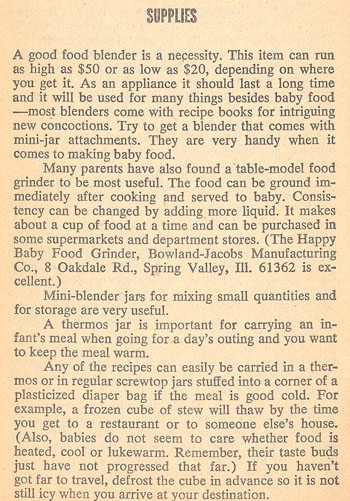 Here is my Osterizer mini-jar:
Here is my Osterizer mini-jar:
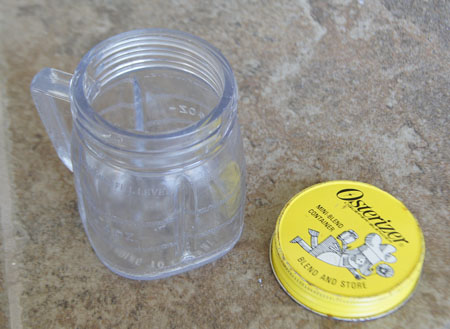 It still works with my current Osterizer blender. I should try it sometime!
It still works with my current Osterizer blender. I should try it sometime!
I got a kick out of the excerpt below on “Shopping”. Check out local stores? Yeah, I do that! I consider it a hobby. But then again, back in the 1970s some of the “health food” stores were pretty iffy. I remember several as dank with wooden floors, with organic produce that was spotty and marginal, and shelves stuffed with all sorts of odd and interesting items. Today’s markets such as Whole Foods are a couple generations bright and cleaner and are more comprehensive. (But they sure have a lot of flashy-packaged products.)
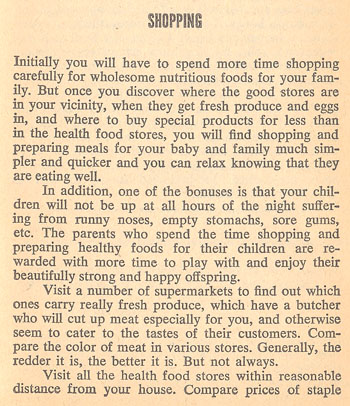
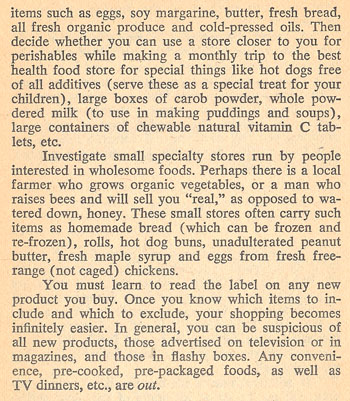 Did you catch that last paragraph? “In general, you can be suspicious of all new products, those advertised on television or in magazines, and those in flashy boxes.” Can one even find a package of food these days that is not in a flashy package??
Did you catch that last paragraph? “In general, you can be suspicious of all new products, those advertised on television or in magazines, and those in flashy boxes.” Can one even find a package of food these days that is not in a flashy package??
Part III gets – finally! – to the recipes. Only one-quarter of this book is recipes! I guess I’m a recipe sort of person.
The first recipe is “Banana”. 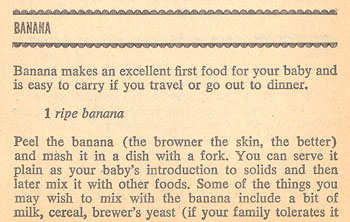
![]() First vegetables include acorn squash. I mention this because when I was babysitting a couple weeks ago, my 7 month old ate acorn squash – so it can be my “recipe” for this blog. My daughter put an acorn squash in the oven, and I took it out 45 minutes later. All I did was take it out and let it cool, then fed some to little Kekeli. He liked it!
First vegetables include acorn squash. I mention this because when I was babysitting a couple weeks ago, my 7 month old ate acorn squash – so it can be my “recipe” for this blog. My daughter put an acorn squash in the oven, and I took it out 45 minutes later. All I did was take it out and let it cool, then fed some to little Kekeli. He liked it!
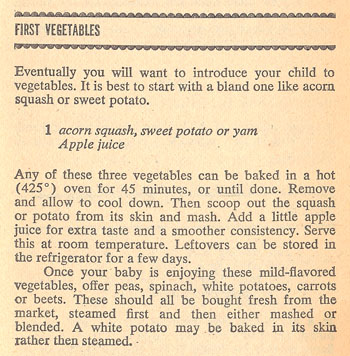
Here is a list of common ingredients in the recipe pages:
Fresh fruits, avocados, acorn squash, yams, carrots, potatoes, celery, green beans, milk, yogurt, cottage cheese, meats (purchased fresh from your local butcher), canned salmon (make sure it has no additives), barley, split peas, safflower oil, wheat germ, brewer’s yeast, Tigers milk, sesame seeds, coconut, powdered milk, peanut buttter, honey, raw sugar. Eggs are always specified as “eggs (raw)”. For flour, they suggest unbleached white flour OR use half soy and half whole wheat flours.
“Crepes” is one of the recipes. Below are some filling suggestions from Making Your Own Baby Food:
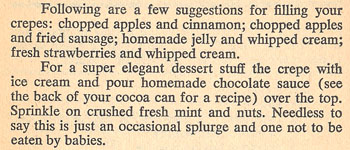 I like this: “Needless to say this is just an occasional splurge and one not to be eaten by babies.”
I like this: “Needless to say this is just an occasional splurge and one not to be eaten by babies.”
The last section is the appendices. The suggested reading list (books) and the magazine bibliography (periodicals) and book and pamphlet lists are outdated (published by 1978) and not of much use to me. She included a bibliographic footnote list for each chapter. “Proposed Rules for Labeling Baby Foods” is a 10-page very small print reproduction of an article in the Federal Register, vol. 41, no. 174, September 7, 1976.
I did find it interesting to read Making Your Own Baby Food again. But, it this book will go into the recycle pile.
Update: one week later. I was fortunate enough to spend some time with my 8 month old grandson this week. We were at a park and fed him crackers and spaghetti. “What is this weird stuff” he seemed to be asking.




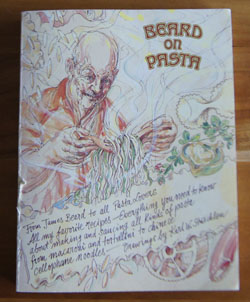
 The tomatoes need to be peeled, seeded, and chopped, and Beard has directions for this on page 16. In a class at the
The tomatoes need to be peeled, seeded, and chopped, and Beard has directions for this on page 16. In a class at the  I am inspired by Beard’s “Pasta with Beans” recipe on page 90. The ingredients are: white beans, bacon, onions, carrots, herbs, canned tomatoes, and elbow macaroni. I have some great home-cooked
I am inspired by Beard’s “Pasta with Beans” recipe on page 90. The ingredients are: white beans, bacon, onions, carrots, herbs, canned tomatoes, and elbow macaroni. I have some great home-cooked 
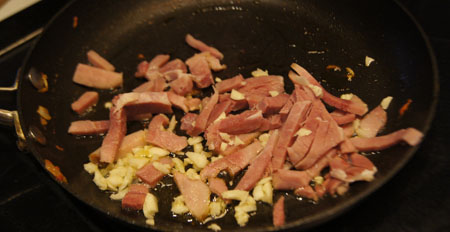 Beard is big on cheese. But, I don’t have a lot of good, chunk Parmesan cheese in my refrigerator – and I’ve decided to make this meal with what I have on hand. I sniff all my cheeses, grate up the last (hard) chunk of Parmesan, add a bit of another sharp white cheese, and use the last of my pre-shredded Parmesan.
Beard is big on cheese. But, I don’t have a lot of good, chunk Parmesan cheese in my refrigerator – and I’ve decided to make this meal with what I have on hand. I sniff all my cheeses, grate up the last (hard) chunk of Parmesan, add a bit of another sharp white cheese, and use the last of my pre-shredded Parmesan.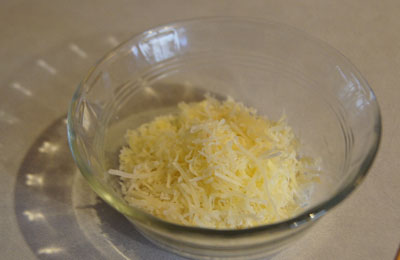 I made a loaf of
I made a loaf of 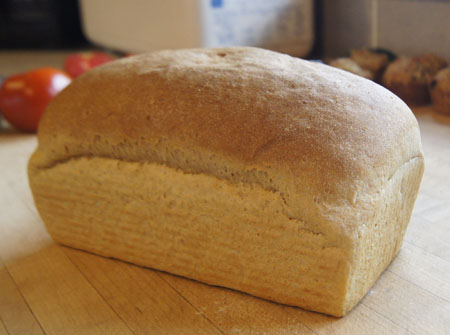
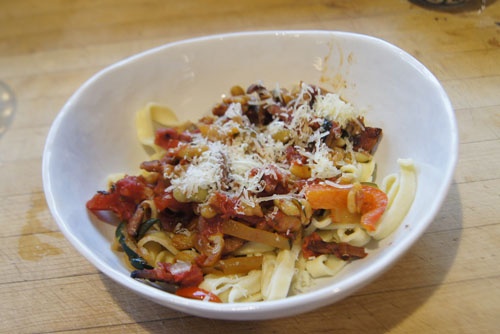

 And as in the 1955 edition, it is a woman who is doing the cooking, or at least reading the cookbook.
And as in the 1955 edition, it is a woman who is doing the cooking, or at least reading the cookbook. The first section is Appetizers and Spreads. Mother marked several: Crab Meat Canapes, Salami-Julienne Spread, and Cheese Onion Balls. These are all made with cream cheese, cottage cheese, and/or sour cream, with additions of canned or frozen products. During the 50s, and especially during the cocktail hour, these types of appetizers were a mainstay of American cookery.
The first section is Appetizers and Spreads. Mother marked several: Crab Meat Canapes, Salami-Julienne Spread, and Cheese Onion Balls. These are all made with cream cheese, cottage cheese, and/or sour cream, with additions of canned or frozen products. During the 50s, and especially during the cocktail hour, these types of appetizers were a mainstay of American cookery.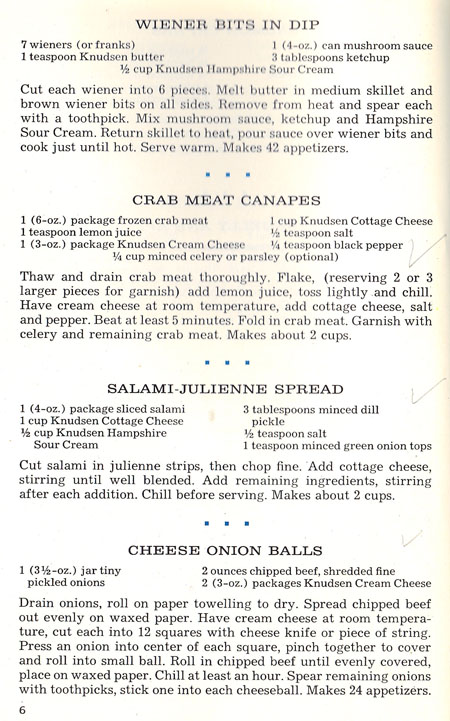 Here is a photo of some of the appetizers:
Here is a photo of some of the appetizers: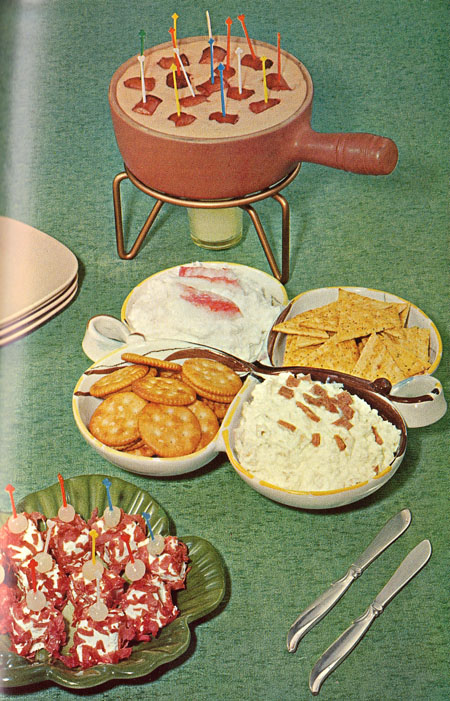 Next is Salads. Mother put a check mark on “Carrot and Red Cabbage Salad”. I thought about making this salad, since I like the combination of carrots and cabbage, but this recipe has more sour cream than I think I’d like. A “Full Meal” salad mixes leftover cooked meat with canned or fresh vegetables and a lot of cottage cheese and sour cream. Not for me. Nor are the molded salads. I guess this whole chapter is just not for me!
Next is Salads. Mother put a check mark on “Carrot and Red Cabbage Salad”. I thought about making this salad, since I like the combination of carrots and cabbage, but this recipe has more sour cream than I think I’d like. A “Full Meal” salad mixes leftover cooked meat with canned or fresh vegetables and a lot of cottage cheese and sour cream. Not for me. Nor are the molded salads. I guess this whole chapter is just not for me!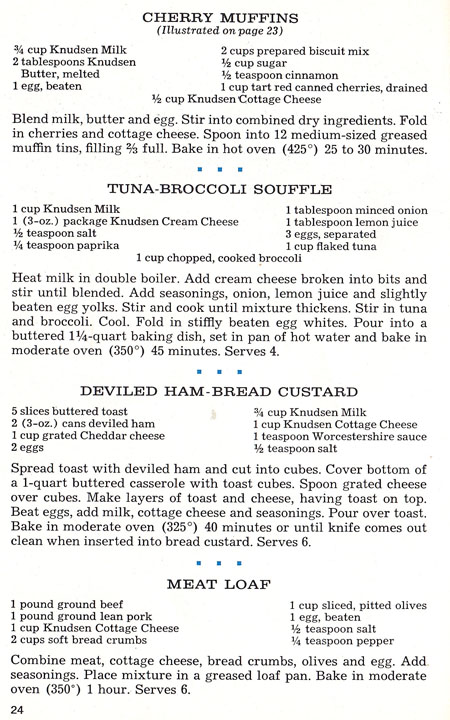

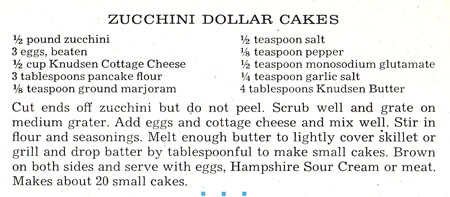
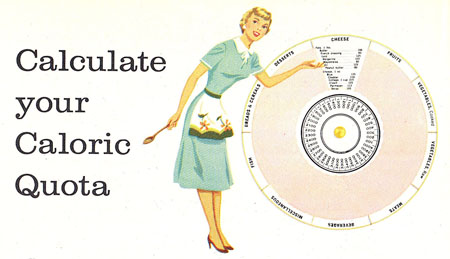 Next is a rave for all the good things about yogurt, hoop cheese, and milk. “Looking for New Ideas? Ways to use cottage cheese” lists a page of ideas. The following one is my favorite. “The men like this with old-fashioned hot potato salad.”
Next is a rave for all the good things about yogurt, hoop cheese, and milk. “Looking for New Ideas? Ways to use cottage cheese” lists a page of ideas. The following one is my favorite. “The men like this with old-fashioned hot potato salad.” “Looking for New Ideas? Ways to use sour cream” is next, and here is my favorite from that list. “Gourmets babble?”
“Looking for New Ideas? Ways to use sour cream” is next, and here is my favorite from that list. “Gourmets babble?”
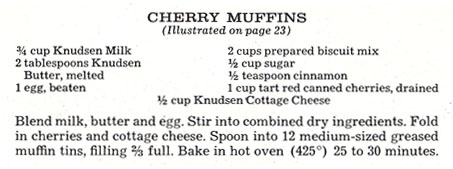 The first issue I need to address in baking these muffins is the “2 cups prepared biscuit mix”. Biscuit mix, or “Bisquick”, was a staple in American kitchens in the 1950s. It is still available today. Should I purchase a box of Bisquick to make this recipe? I think not. I have no other use for it, and in general, I like cooking from scratch, so that I know my ingredients. Luckily, at some time in the recent past I had copied from the web search results for a substitution for biscuit mix:
The first issue I need to address in baking these muffins is the “2 cups prepared biscuit mix”. Biscuit mix, or “Bisquick”, was a staple in American kitchens in the 1950s. It is still available today. Should I purchase a box of Bisquick to make this recipe? I think not. I have no other use for it, and in general, I like cooking from scratch, so that I know my ingredients. Luckily, at some time in the recent past I had copied from the web search results for a substitution for biscuit mix: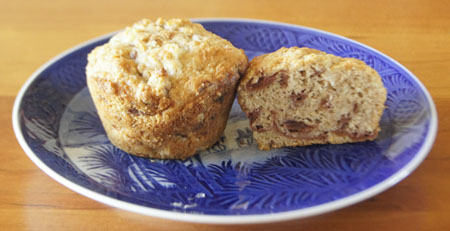 These were a lot better than I expected! I was concerned that the cherries would not lend enough flavor to the muffins, but I was very wrong. Also, I often use vegetable oil in muffins, but used butter in these. Same calories, but what a difference in texture! These almost taste like pie crust.
These were a lot better than I expected! I was concerned that the cherries would not lend enough flavor to the muffins, but I was very wrong. Also, I often use vegetable oil in muffins, but used butter in these. Same calories, but what a difference in texture! These almost taste like pie crust. This booklet of 26 recipes must have come with our Weber gas grill. I have forgotten all about this cookbook, since soon after getting the grill I purchased Weber’s Real Grilling, a large cookbook with tons of recipes.
This booklet of 26 recipes must have come with our Weber gas grill. I have forgotten all about this cookbook, since soon after getting the grill I purchased Weber’s Real Grilling, a large cookbook with tons of recipes.
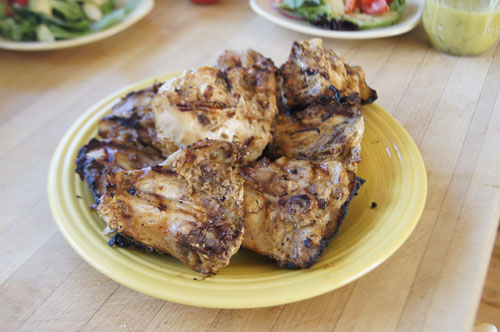 These tasted great! The yogurt marinade makes them not only well seasoned, it also makes them very tender. (I put the blackened side down for the photo. They would have been so much prettier if I hadn’t tried something experimental!)
These tasted great! The yogurt marinade makes them not only well seasoned, it also makes them very tender. (I put the blackened side down for the photo. They would have been so much prettier if I hadn’t tried something experimental!)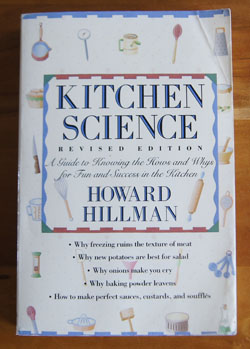
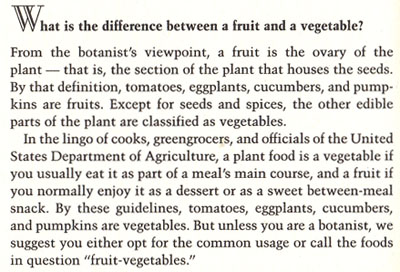
 I took the eggs out of the carton in the same order and laid them on a cloth with the upper ends to the right for each egg. Note how hard it can be to find the flatter end – sometimes both ends look the same.
I took the eggs out of the carton in the same order and laid them on a cloth with the upper ends to the right for each egg. Note how hard it can be to find the flatter end – sometimes both ends look the same.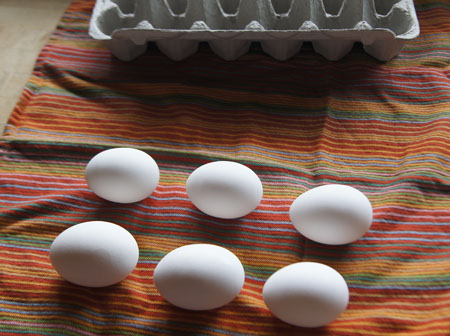 Below is a close-up of these same eggs. I am tilting one egg, flat side up:
Below is a close-up of these same eggs. I am tilting one egg, flat side up: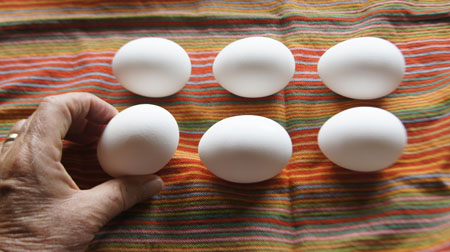

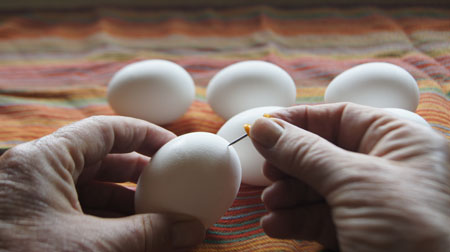 Poked hole:
Poked hole: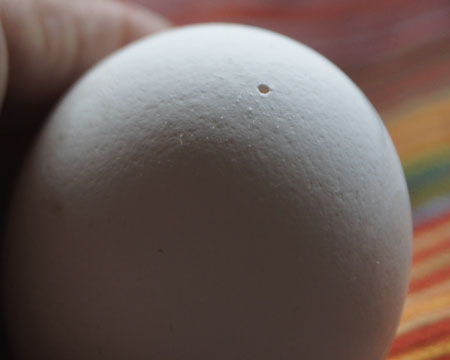
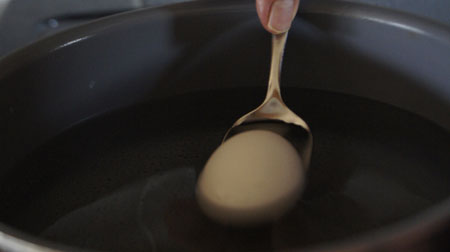 As careful as I was to remove the eggs from the carton properly and poke what looked like the flatter end, one of the eggs had been put in the carton upside down was thus in the wrong orientation (the upper left egg in the pattern of six). Instead of bubbles, white goo came out when I lowered it into the boiIing water. I removed it immediately. Here is the gooey egg white coming out of the hole in the upper left egg:
As careful as I was to remove the eggs from the carton properly and poke what looked like the flatter end, one of the eggs had been put in the carton upside down was thus in the wrong orientation (the upper left egg in the pattern of six). Instead of bubbles, white goo came out when I lowered it into the boiIing water. I removed it immediately. Here is the gooey egg white coming out of the hole in the upper left egg:
 Conclusion: In my opinion, the 15-minute eggs were a bit undercooked. Here is a close-up, with a 15-minute egg on the left, and a 20-minute egg on the right:
Conclusion: In my opinion, the 15-minute eggs were a bit undercooked. Here is a close-up, with a 15-minute egg on the left, and a 20-minute egg on the right: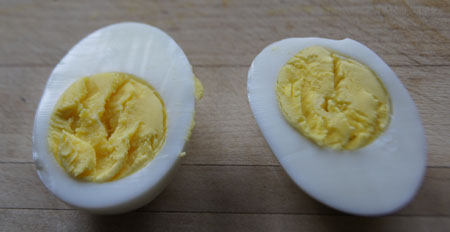 Neither has a dark green discoloration on the sides of the yolk.
Neither has a dark green discoloration on the sides of the yolk.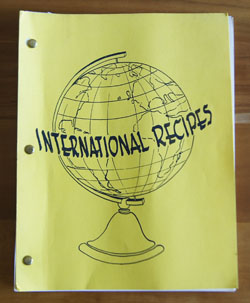 No author, no publisher, no publication date! This is the only cookbook in my collection with none of that information. It is a
No author, no publisher, no publication date! This is the only cookbook in my collection with none of that information. It is a  I read through this entire book, and am impressed with the author’s work. She (I assume it was a woman, at least) set up each section with an entire menu of recipes for the particular international cuisine. She referenced a sauce from one section (a raspberry sauce) that might go with a recipe from another section (a pecan torte). Because of the consistent writing style and the cross-references, I think this book was all written by one person, although she may have collected ideas from friends of different cultures. The recipes call for canned or processed items, like bean sprouts, canned shrimp and crab, and cake mixes; canned coconut milk was not available; there are several gelatin salad recipes; and microwaves and food processors are not mentioned. All of these facts lead me to believe it was produced in the sixties or seventies. Plus, it was prepared on a typewriter, not a computer.
I read through this entire book, and am impressed with the author’s work. She (I assume it was a woman, at least) set up each section with an entire menu of recipes for the particular international cuisine. She referenced a sauce from one section (a raspberry sauce) that might go with a recipe from another section (a pecan torte). Because of the consistent writing style and the cross-references, I think this book was all written by one person, although she may have collected ideas from friends of different cultures. The recipes call for canned or processed items, like bean sprouts, canned shrimp and crab, and cake mixes; canned coconut milk was not available; there are several gelatin salad recipes; and microwaves and food processors are not mentioned. All of these facts lead me to believe it was produced in the sixties or seventies. Plus, it was prepared on a typewriter, not a computer.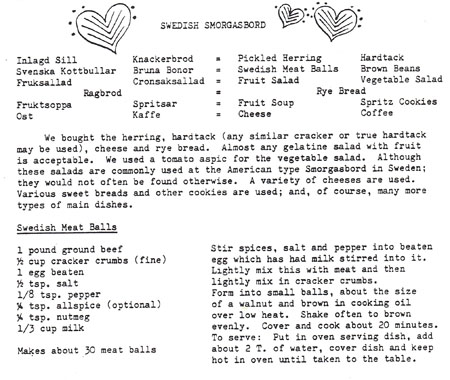
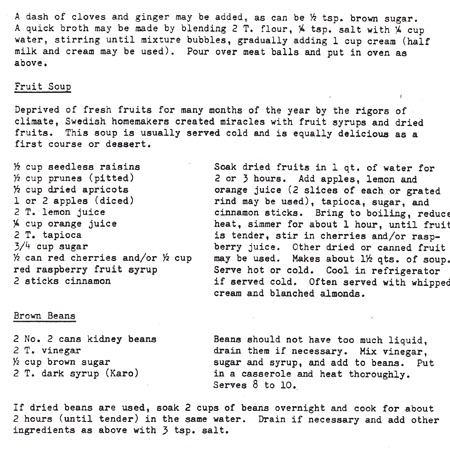 Hungary: Hungarian Gulyas (like a goulash), Wilted Cucumbers, Cole Slaw, Cream Apples.
Hungary: Hungarian Gulyas (like a goulash), Wilted Cucumbers, Cole Slaw, Cream Apples.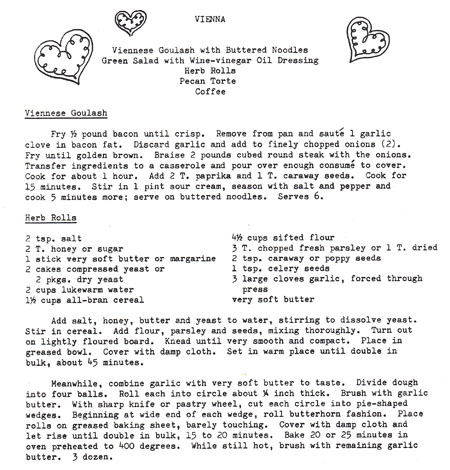

 I put the rolls on 2 parchment-lined half sheet pans and let them rise about 20 minutes (my kitchen was warm). I learned from experience that the rolls bake up best if you tuck the pointy ends under the rolls.
I put the rolls on 2 parchment-lined half sheet pans and let them rise about 20 minutes (my kitchen was warm). I learned from experience that the rolls bake up best if you tuck the pointy ends under the rolls.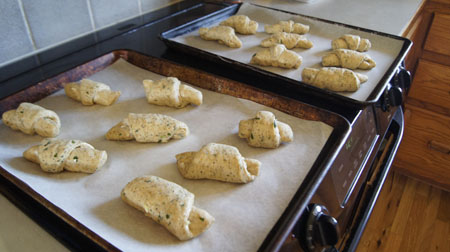
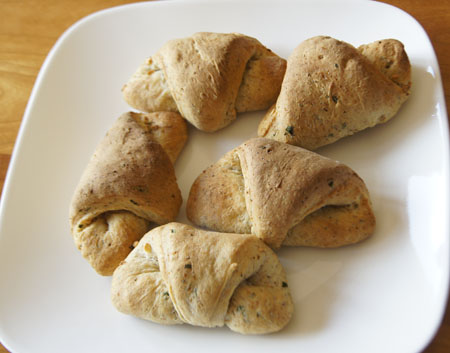 A “yum” for this recipe! These are soft and tasty, and fun to make. The bread machine method worked great. I put some of the rolls in the freezer for later use. Yes, I’d make these again!
A “yum” for this recipe! These are soft and tasty, and fun to make. The bread machine method worked great. I put some of the rolls in the freezer for later use. Yes, I’d make these again!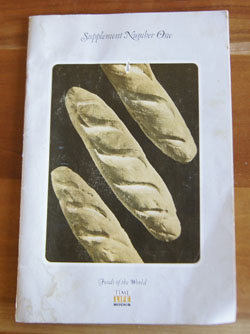 I own 5 of the 27 Foods of the World volumes produced by Time-Life Books, and have covered 4 of them so far:
I own 5 of the 27 Foods of the World volumes produced by Time-Life Books, and have covered 4 of them so far: 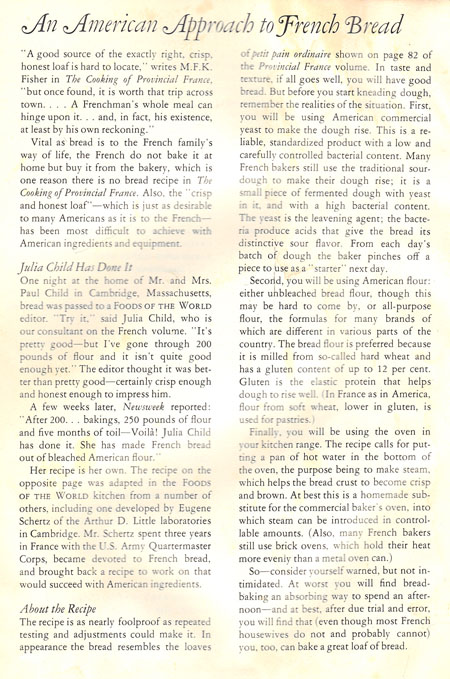 Note in the above discussion that in France, most people buy their bread fresh daily in the bakeries, or
Note in the above discussion that in France, most people buy their bread fresh daily in the bakeries, or 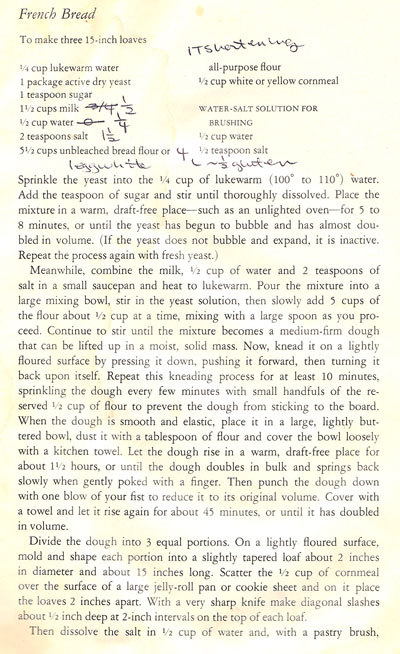

 I also added 1 egg white to the dough. I forget where I got that idea, but I found it essential for making a good loaf. I also added 1 tablespoon shortening – I forget why. I discovered early on the advantage of adding vital wheat gluten flour to my loaves, so the changes I made to the recipe include using 1/2 cup gluten flour in the total 4 cups of flour, (the rest was all-purpose flour).
I also added 1 egg white to the dough. I forget where I got that idea, but I found it essential for making a good loaf. I also added 1 tablespoon shortening – I forget why. I discovered early on the advantage of adding vital wheat gluten flour to my loaves, so the changes I made to the recipe include using 1/2 cup gluten flour in the total 4 cups of flour, (the rest was all-purpose flour).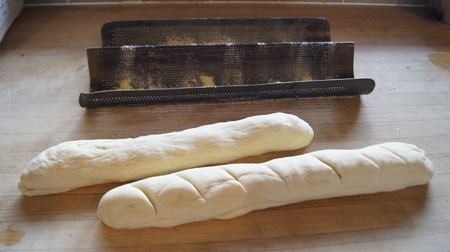
 I am very pleased with the results. Granted, I made some of the slashes too deep so it may not look perfect, but the crust is golden brown and good and crunchy. The inside has a good “crumb”, sort of halfway between kneaded breads and no-knead breads. (No-knead breads are more like the artisan loaves we buy locally.) I like the flavor, too. Some chefs argue that true French bread has no milk or butter in it, but I like it this way.
I am very pleased with the results. Granted, I made some of the slashes too deep so it may not look perfect, but the crust is golden brown and good and crunchy. The inside has a good “crumb”, sort of halfway between kneaded breads and no-knead breads. (No-knead breads are more like the artisan loaves we buy locally.) I like the flavor, too. Some chefs argue that true French bread has no milk or butter in it, but I like it this way.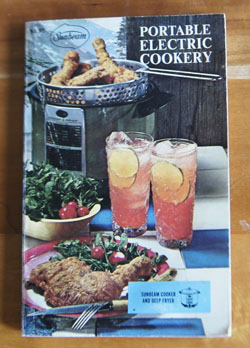 I wrote in my database that Portable Electric Cookery “came with my deep fat fryer”, and it has recipes written for deep fat fryers, electric fry pans, blenders, and electric mixers. I covered the deep fat fryer in
I wrote in my database that Portable Electric Cookery “came with my deep fat fryer”, and it has recipes written for deep fat fryers, electric fry pans, blenders, and electric mixers. I covered the deep fat fryer in 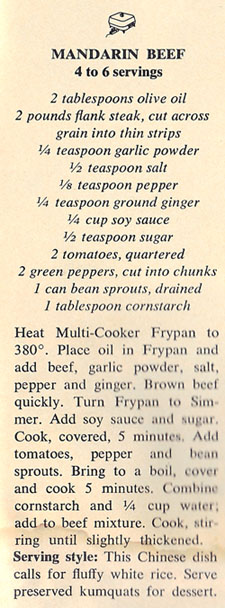 I don’t feel like pulling out my electric fry pan, so I’ll just use one of my stove-top frying pans. For the two of us, I’ll halve the recipe. Instead of the canned bean sprouts, I will substitute with julienned zucchini (I would have used fresh bean sprouts, but forgot to buy them!). I did have mushrooms, so I used them in this dish. And I’ll use fresh ginger and garlic. Tomatoes and fresh ginger and garlic remind me of the base for many dishes my daughter cooked for us in Togo. I think we will like this Mandarin Beef.
I don’t feel like pulling out my electric fry pan, so I’ll just use one of my stove-top frying pans. For the two of us, I’ll halve the recipe. Instead of the canned bean sprouts, I will substitute with julienned zucchini (I would have used fresh bean sprouts, but forgot to buy them!). I did have mushrooms, so I used them in this dish. And I’ll use fresh ginger and garlic. Tomatoes and fresh ginger and garlic remind me of the base for many dishes my daughter cooked for us in Togo. I think we will like this Mandarin Beef.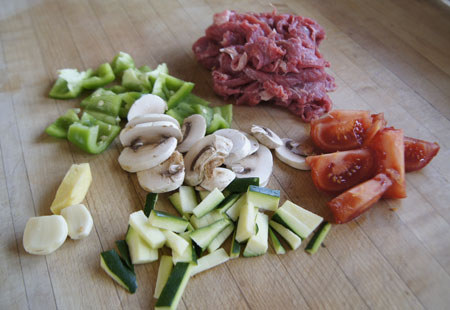
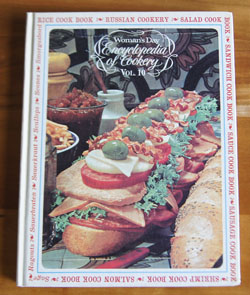 I have a set of twelve Encyclopedia of Cookery volumes and this is the tenth of that set – I covered the first nine in previous posts. I’ve enjoyed all of them so far! This volume covers curious and helpful information about foods from (q)uail to (sor)rel.
I have a set of twelve Encyclopedia of Cookery volumes and this is the tenth of that set – I covered the first nine in previous posts. I’ve enjoyed all of them so far! This volume covers curious and helpful information about foods from (q)uail to (sor)rel.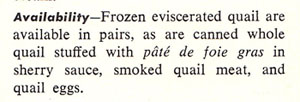 “Quantity cooking” is covered in about ten pages of handy hints, instructions, and recipes. Largely it is for homecooks who need to cook for community events, family gatherings, and bake sales. “Quenelles” are fish dumplings (I made these once, years ago). “Quiche” is “a savory baked custard tart thought to have originated in Lorraine, a province of eastern France bordering on Germany”. The word quiche derives from a word from a French-German dialect that means kuchen, or “cake” (and I have a longing for a kuchen I once had). Mother labelled as “delicious” the recipe for “Quiche Lorraine with Swiss Cheese”.
“Quantity cooking” is covered in about ten pages of handy hints, instructions, and recipes. Largely it is for homecooks who need to cook for community events, family gatherings, and bake sales. “Quenelles” are fish dumplings (I made these once, years ago). “Quiche” is “a savory baked custard tart thought to have originated in Lorraine, a province of eastern France bordering on Germany”. The word quiche derives from a word from a French-German dialect that means kuchen, or “cake” (and I have a longing for a kuchen I once had). Mother labelled as “delicious” the recipe for “Quiche Lorraine with Swiss Cheese”.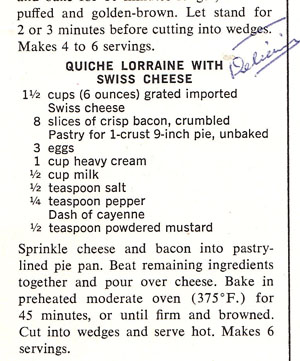 Rabbit, raccoon, radish, rampion (a bellflower used for its edibible root and tender young leaves). “Ratatouille” is a stew or casserole that includes eggplant, zucchini, and green pepper. A “Recipe” is: “a formula for preparing a dish. In old-fashioned usage the words ‘receipt’ or ‘rule’ were often used to mean the same thing.” Aha, back to formulas and chemistry. “Reindeer”! I hope I never have to cook one, but at least now I have a recipe.
Rabbit, raccoon, radish, rampion (a bellflower used for its edibible root and tender young leaves). “Ratatouille” is a stew or casserole that includes eggplant, zucchini, and green pepper. A “Recipe” is: “a formula for preparing a dish. In old-fashioned usage the words ‘receipt’ or ‘rule’ were often used to mean the same thing.” Aha, back to formulas and chemistry. “Reindeer”! I hope I never have to cook one, but at least now I have a recipe.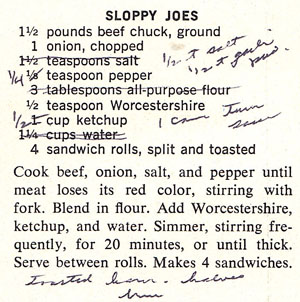 I like a few of the recipes in this section, but like salads, I usually make sandwiches “on the go”, or from ideas picked up from restaurants. Many of the sandwich recipes in this book employ sandwich fillings (kind of like our current-day tuna and chicken salads) that employ a variety of ingredients, including sardines, chopped liver, tongue, or eggs. I might make the “Ham Salad Rolls” 1604, with diced cooked ham, cabbage, celery, green pepper, egg, mustard, and salad dressing on a hot dog roll. There are also recipes for a variety of hot, cold, and open-faced sandwiches.
I like a few of the recipes in this section, but like salads, I usually make sandwiches “on the go”, or from ideas picked up from restaurants. Many of the sandwich recipes in this book employ sandwich fillings (kind of like our current-day tuna and chicken salads) that employ a variety of ingredients, including sardines, chopped liver, tongue, or eggs. I might make the “Ham Salad Rolls” 1604, with diced cooked ham, cabbage, celery, green pepper, egg, mustard, and salad dressing on a hot dog roll. There are also recipes for a variety of hot, cold, and open-faced sandwiches.
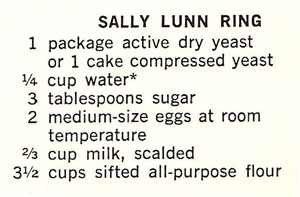
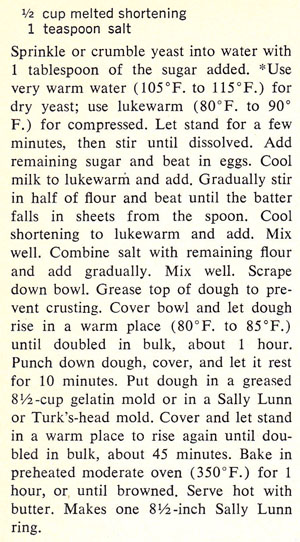
 After the second rise, the dough is not quite to the top of the loaf pan. I let it rise in the pan for 40 minutes because I wanted it higher. Still, I went ahead and put it in the oven.
After the second rise, the dough is not quite to the top of the loaf pan. I let it rise in the pan for 40 minutes because I wanted it higher. Still, I went ahead and put it in the oven.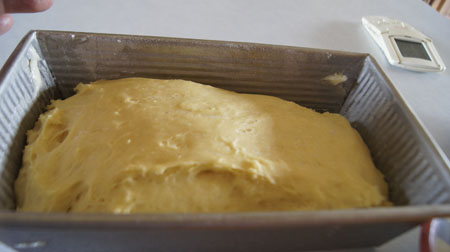 And voila! After baking the bread was just over the top of the pan, and dark golden brown. The crumb of the bread was perfect.
And voila! After baking the bread was just over the top of the pan, and dark golden brown. The crumb of the bread was perfect.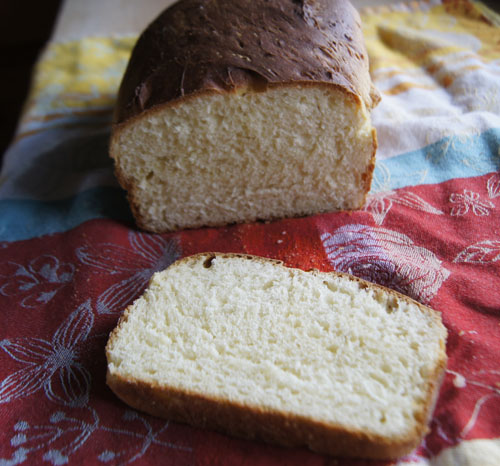 This Sally Lunn bread is rich with eggs, milk, and butter, but not too sweet with sugar. The flavor is reminiscent of a brioche. The “crumb” is between a yeast bread and cake in texture. I served it with a dollop of ice cream and a lot of fresh raspberries for dessert. The next day(s), it was great toasted with jam for breakfast. Yay for Sally Lunn!
This Sally Lunn bread is rich with eggs, milk, and butter, but not too sweet with sugar. The flavor is reminiscent of a brioche. The “crumb” is between a yeast bread and cake in texture. I served it with a dollop of ice cream and a lot of fresh raspberries for dessert. The next day(s), it was great toasted with jam for breakfast. Yay for Sally Lunn! This is one of four Hershey’s cookbooks in my cookbook database. I can’t find the publication date anywhere in my copy, but online photos and details of the same book on Amazon claim “1982” as the date.
This is one of four Hershey’s cookbooks in my cookbook database. I can’t find the publication date anywhere in my copy, but online photos and details of the same book on Amazon claim “1982” as the date. Mother did not mark any of the recipes! This is unusual for her, especially for cookie, pie, and cake recipes, which include all of the recipes in this cookbook.
Mother did not mark any of the recipes! This is unusual for her, especially for cookie, pie, and cake recipes, which include all of the recipes in this cookbook.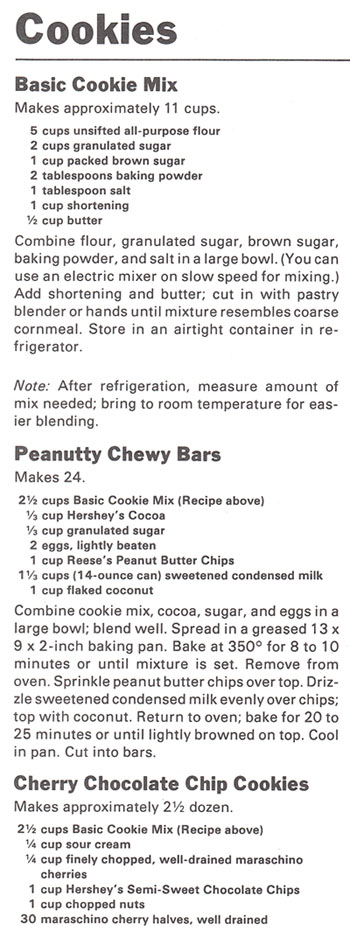
 I’m not sure I’ll always want to make “cookie mix” and then the cookies, so I made a half recipe of the mix, then measured it. It made enough for two different types (or batches) of cookies.
I’m not sure I’ll always want to make “cookie mix” and then the cookies, so I made a half recipe of the mix, then measured it. It made enough for two different types (or batches) of cookies. Wow, were these ever good! Very, very tender. I realized as I made the dough that this is how I make pie crust, by first combining the flour-sugar and shortening, then blending in the wet ingredients. Usually cookies are made by combining the sugar and shortening and any wet ingredients, then adding the dry ingredients. The result of the “Basic Cookie Dough” method is that the cookies taste tender, like pie crust.
Wow, were these ever good! Very, very tender. I realized as I made the dough that this is how I make pie crust, by first combining the flour-sugar and shortening, then blending in the wet ingredients. Usually cookies are made by combining the sugar and shortening and any wet ingredients, then adding the dry ingredients. The result of the “Basic Cookie Dough” method is that the cookies taste tender, like pie crust.